Introduction to Business Law: Australian Legal System and Structures
VerifiedAdded on 2021/04/17
|12
|2798
|48
Report
AI Summary
This report provides a comprehensive overview of the Australian legal system and its implications for businesses. It begins with an introduction to the Australian legal framework, emphasizing the role of the Constitution and the distribution of law-making powers. The report then delves into the context of business operations, highlighting the legal requirements businesses must adhere to, including employment laws, fair trading regulations, and taxation. It examines four common business structures in Australia: sole trader, partnership, company, and trust, outlining their key characteristics. A case study of BHP Billiton is included, analyzing its structure and compliance with relevant laws. The report further evaluates the advantages and disadvantages of a company structure, comparing it with other structures like sole trader, partnership, and trust, and discussing aspects such as liability, capital raising, taxation, and decision-making processes. The conclusion summarizes the key findings, emphasizing the importance of understanding the legal system for effective business operations.
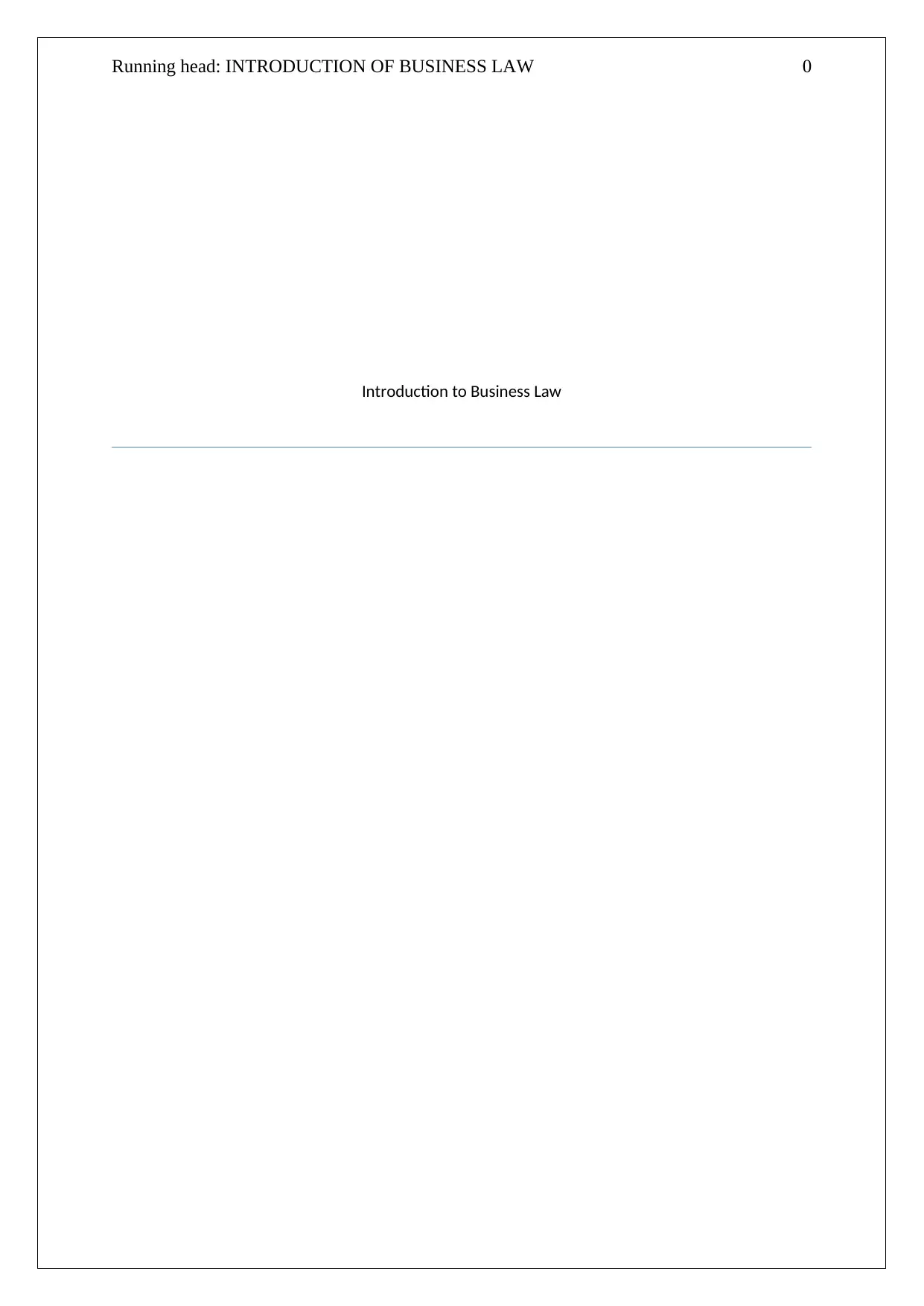
Running head: INTRODUCTION OF BUSINESS LAW 0
Introduction to Business Law
Introduction to Business Law
Paraphrase This Document
Need a fresh take? Get an instant paraphrase of this document with our AI Paraphraser
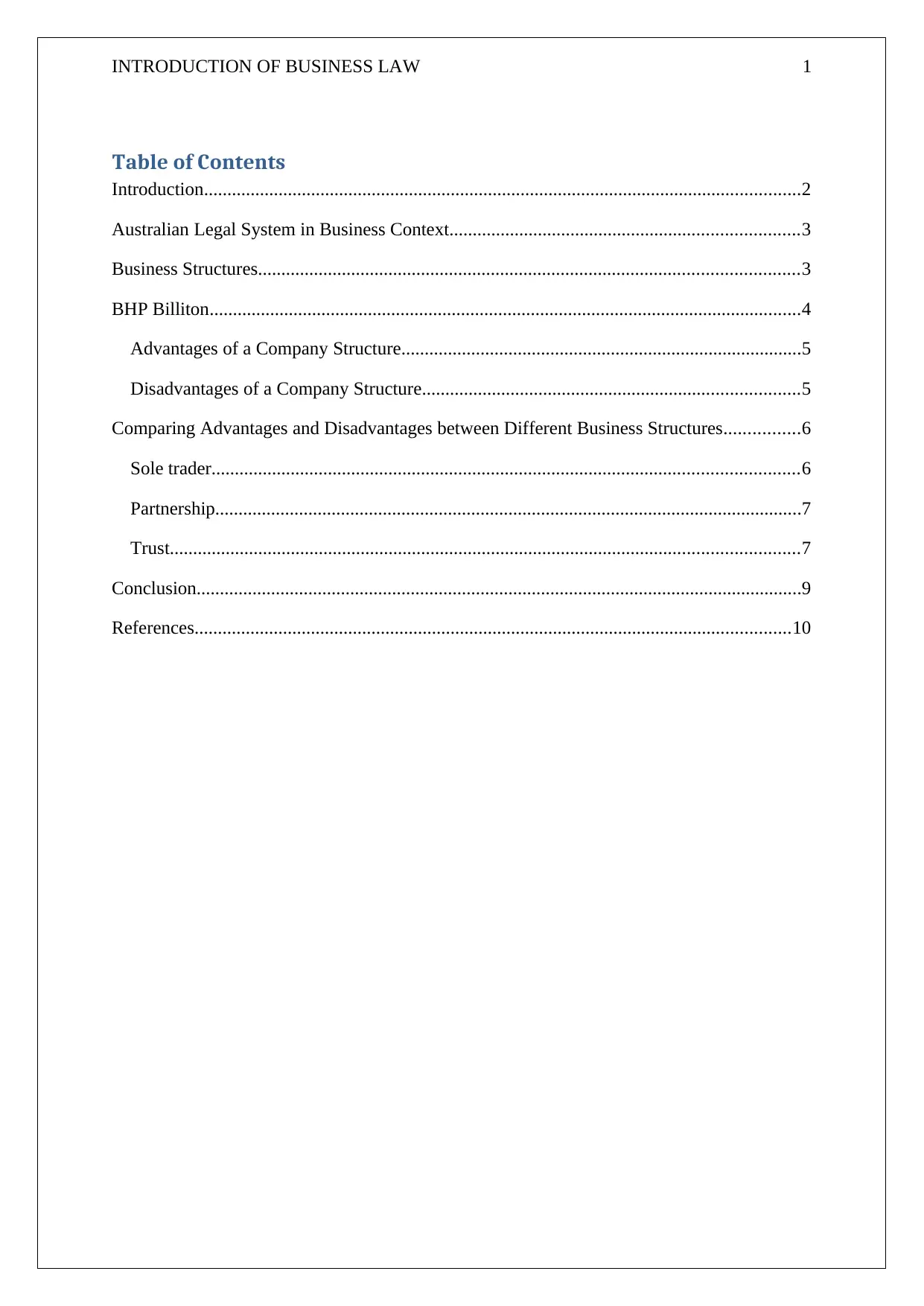
INTRODUCTION OF BUSINESS LAW 1
Table of Contents
Introduction................................................................................................................................2
Australian Legal System in Business Context...........................................................................3
Business Structures....................................................................................................................3
BHP Billiton...............................................................................................................................4
Advantages of a Company Structure......................................................................................5
Disadvantages of a Company Structure.................................................................................5
Comparing Advantages and Disadvantages between Different Business Structures................6
Sole trader..............................................................................................................................6
Partnership..............................................................................................................................7
Trust.......................................................................................................................................7
Conclusion..................................................................................................................................9
References................................................................................................................................10
Table of Contents
Introduction................................................................................................................................2
Australian Legal System in Business Context...........................................................................3
Business Structures....................................................................................................................3
BHP Billiton...............................................................................................................................4
Advantages of a Company Structure......................................................................................5
Disadvantages of a Company Structure.................................................................................5
Comparing Advantages and Disadvantages between Different Business Structures................6
Sole trader..............................................................................................................................6
Partnership..............................................................................................................................7
Trust.......................................................................................................................................7
Conclusion..................................................................................................................................9
References................................................................................................................................10

INTRODUCTION OF BUSINESS LAW 2
Introduction
The Australian legal system is founded by its Constitution which provides the power
of federal and state government. The constitution had distributed law-making powers
between Commonwealth and state government (Ward, 2011). The Australian legal system
has developed from the principle of English common law. While conducting their operations
in Australia, businesses have to ensure that they comply with necessary legal requirements in
order to avoid legal consequences. Each legal structure has different legal requirements
which are necessary to be followed by its owners, therefore, it is necessary that owners
carefully assess the legal structure and its requirements (Attorney-General’s Department,
2018). The legal system in Australia ensures that organisations did not violate customers’
rights, and they conduct fair trading practices. This report will evaluate the Australian legal
system and its regulations in the context of business structures. This report will analyse
different business structures in Australia and analyse the structure of BHP Billiton. Further,
the report will evaluate the advantages and disadvantage of BHP Billiton’s legal structure and
compared it with other structures.
Introduction
The Australian legal system is founded by its Constitution which provides the power
of federal and state government. The constitution had distributed law-making powers
between Commonwealth and state government (Ward, 2011). The Australian legal system
has developed from the principle of English common law. While conducting their operations
in Australia, businesses have to ensure that they comply with necessary legal requirements in
order to avoid legal consequences. Each legal structure has different legal requirements
which are necessary to be followed by its owners, therefore, it is necessary that owners
carefully assess the legal structure and its requirements (Attorney-General’s Department,
2018). The legal system in Australia ensures that organisations did not violate customers’
rights, and they conduct fair trading practices. This report will evaluate the Australian legal
system and its regulations in the context of business structures. This report will analyse
different business structures in Australia and analyse the structure of BHP Billiton. Further,
the report will evaluate the advantages and disadvantage of BHP Billiton’s legal structure and
compared it with other structures.
⊘ This is a preview!⊘
Do you want full access?
Subscribe today to unlock all pages.

Trusted by 1+ million students worldwide
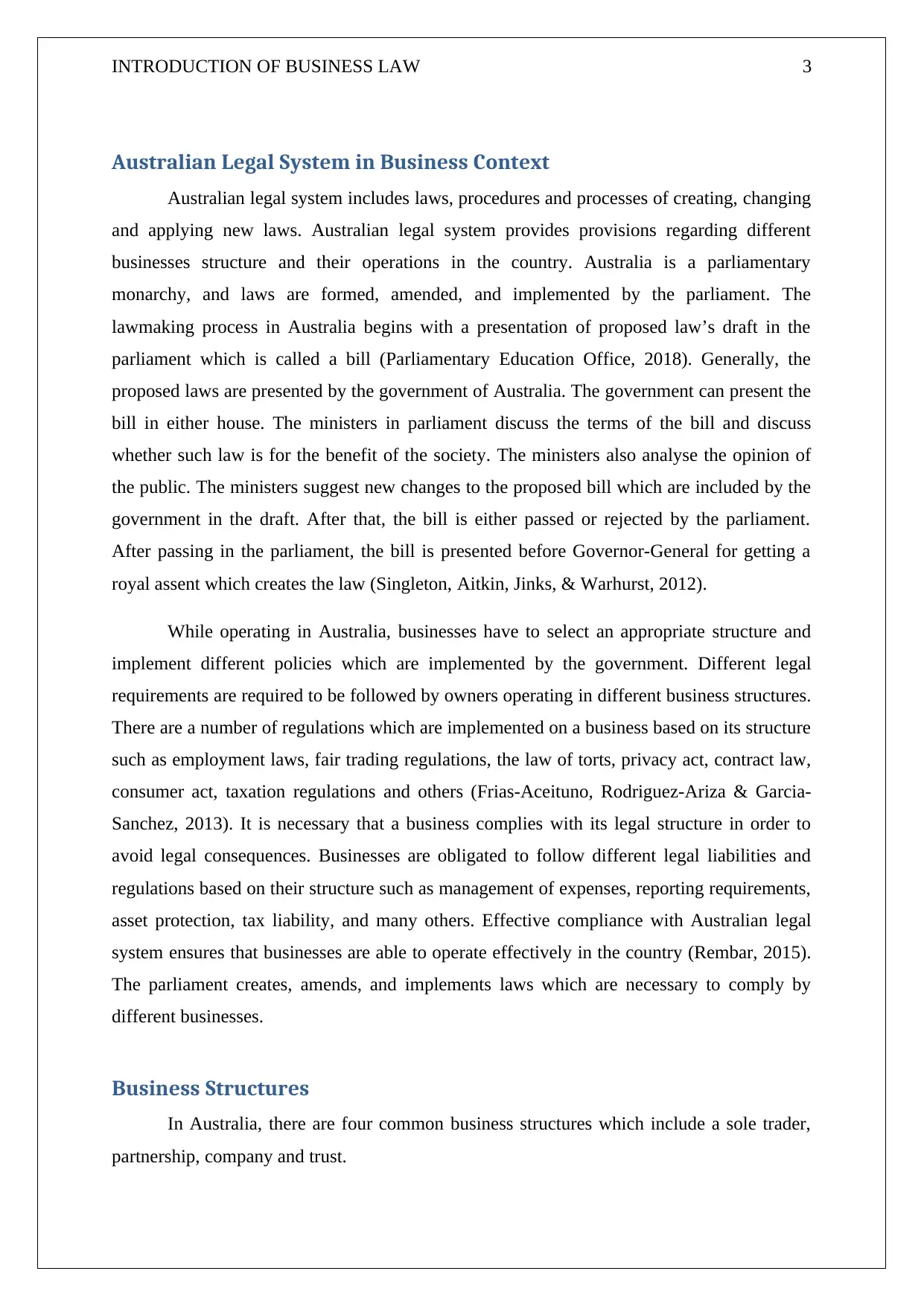
INTRODUCTION OF BUSINESS LAW 3
Australian Legal System in Business Context
Australian legal system includes laws, procedures and processes of creating, changing
and applying new laws. Australian legal system provides provisions regarding different
businesses structure and their operations in the country. Australia is a parliamentary
monarchy, and laws are formed, amended, and implemented by the parliament. The
lawmaking process in Australia begins with a presentation of proposed law’s draft in the
parliament which is called a bill (Parliamentary Education Office, 2018). Generally, the
proposed laws are presented by the government of Australia. The government can present the
bill in either house. The ministers in parliament discuss the terms of the bill and discuss
whether such law is for the benefit of the society. The ministers also analyse the opinion of
the public. The ministers suggest new changes to the proposed bill which are included by the
government in the draft. After that, the bill is either passed or rejected by the parliament.
After passing in the parliament, the bill is presented before Governor-General for getting a
royal assent which creates the law (Singleton, Aitkin, Jinks, & Warhurst, 2012).
While operating in Australia, businesses have to select an appropriate structure and
implement different policies which are implemented by the government. Different legal
requirements are required to be followed by owners operating in different business structures.
There are a number of regulations which are implemented on a business based on its structure
such as employment laws, fair trading regulations, the law of torts, privacy act, contract law,
consumer act, taxation regulations and others (Frias-Aceituno, Rodriguez-Ariza & Garcia-
Sanchez, 2013). It is necessary that a business complies with its legal structure in order to
avoid legal consequences. Businesses are obligated to follow different legal liabilities and
regulations based on their structure such as management of expenses, reporting requirements,
asset protection, tax liability, and many others. Effective compliance with Australian legal
system ensures that businesses are able to operate effectively in the country (Rembar, 2015).
The parliament creates, amends, and implements laws which are necessary to comply by
different businesses.
Business Structures
In Australia, there are four common business structures which include a sole trader,
partnership, company and trust.
Australian Legal System in Business Context
Australian legal system includes laws, procedures and processes of creating, changing
and applying new laws. Australian legal system provides provisions regarding different
businesses structure and their operations in the country. Australia is a parliamentary
monarchy, and laws are formed, amended, and implemented by the parliament. The
lawmaking process in Australia begins with a presentation of proposed law’s draft in the
parliament which is called a bill (Parliamentary Education Office, 2018). Generally, the
proposed laws are presented by the government of Australia. The government can present the
bill in either house. The ministers in parliament discuss the terms of the bill and discuss
whether such law is for the benefit of the society. The ministers also analyse the opinion of
the public. The ministers suggest new changes to the proposed bill which are included by the
government in the draft. After that, the bill is either passed or rejected by the parliament.
After passing in the parliament, the bill is presented before Governor-General for getting a
royal assent which creates the law (Singleton, Aitkin, Jinks, & Warhurst, 2012).
While operating in Australia, businesses have to select an appropriate structure and
implement different policies which are implemented by the government. Different legal
requirements are required to be followed by owners operating in different business structures.
There are a number of regulations which are implemented on a business based on its structure
such as employment laws, fair trading regulations, the law of torts, privacy act, contract law,
consumer act, taxation regulations and others (Frias-Aceituno, Rodriguez-Ariza & Garcia-
Sanchez, 2013). It is necessary that a business complies with its legal structure in order to
avoid legal consequences. Businesses are obligated to follow different legal liabilities and
regulations based on their structure such as management of expenses, reporting requirements,
asset protection, tax liability, and many others. Effective compliance with Australian legal
system ensures that businesses are able to operate effectively in the country (Rembar, 2015).
The parliament creates, amends, and implements laws which are necessary to comply by
different businesses.
Business Structures
In Australia, there are four common business structures which include a sole trader,
partnership, company and trust.
Paraphrase This Document
Need a fresh take? Get an instant paraphrase of this document with our AI Paraphraser

INTRODUCTION OF BUSINESS LAW 4
Sole trader: In this business structure, a person is responsible for operating and
handling all aspects and functions of a business. The owner invests his/her money in the
business and takes all its business decision. A sole trader can hire employees for performing
different functions of the business. In case the business failed to repay its debts, the court can
use the personal property of the owner for repaying the business’s debts (Department of
Industry, Innovation and Science, 2017a).
Partnership: In this business structure, an association of people joined together into a
legal contract to operate a business. A partnership requires legal association between two or
more people (Department of Industry, Innovation and Science, 2017b).
Company: A corporate legal structure has a separate legal entity from its owner who
operates its business. It can purchase new property and enter into a legal contract with parties
on its own name. In Australia, the Corporations Act 2001 provides different provisions that
are necessary to comply by a company while operating its business (WIPO, 2018).
Trust: In this business structure, an arrangement occurred between parties based on
which an entity holds property or income of another person as a nominal owner in order to
provide benefit to others.
BHP Billiton
BHP Billiton or BHP is a multinational company which was founded in 1885. The
corporation operates in metal and mining industry, and it offers its services worldwide. The
head office of the firm is situated in Melbourne, Victoria, Australia (BHP, 2018a). BHP
Billiton operates under a dual listed company structure in which two corporations (BHP
Billiton PLC and BHP Billiton Limited) are operating as a separate legal entity. Both the
companies are operated by a unified Board and management (BHP, 2018b). The management
of the firm focuses on implementing effective policies for improving cost efficiencies,
technology, major projects, exploration, and latent capacity. The company has to comply with
different legal requirements as per the legal system of Australia. BHP Billiton complies with
different laws including employment regulations, taxation liability, consumer protection act,
fair trading policies, and others. For example, the firm has to ensure that it provides minimum
wage to its workers in order to ensure that their rights are secured. Currently, the minimum
wage rate in Australia is AU$694.90 per 38 hour in a week or AU$18.29 per hour (Fair work,
Sole trader: In this business structure, a person is responsible for operating and
handling all aspects and functions of a business. The owner invests his/her money in the
business and takes all its business decision. A sole trader can hire employees for performing
different functions of the business. In case the business failed to repay its debts, the court can
use the personal property of the owner for repaying the business’s debts (Department of
Industry, Innovation and Science, 2017a).
Partnership: In this business structure, an association of people joined together into a
legal contract to operate a business. A partnership requires legal association between two or
more people (Department of Industry, Innovation and Science, 2017b).
Company: A corporate legal structure has a separate legal entity from its owner who
operates its business. It can purchase new property and enter into a legal contract with parties
on its own name. In Australia, the Corporations Act 2001 provides different provisions that
are necessary to comply by a company while operating its business (WIPO, 2018).
Trust: In this business structure, an arrangement occurred between parties based on
which an entity holds property or income of another person as a nominal owner in order to
provide benefit to others.
BHP Billiton
BHP Billiton or BHP is a multinational company which was founded in 1885. The
corporation operates in metal and mining industry, and it offers its services worldwide. The
head office of the firm is situated in Melbourne, Victoria, Australia (BHP, 2018a). BHP
Billiton operates under a dual listed company structure in which two corporations (BHP
Billiton PLC and BHP Billiton Limited) are operating as a separate legal entity. Both the
companies are operated by a unified Board and management (BHP, 2018b). The management
of the firm focuses on implementing effective policies for improving cost efficiencies,
technology, major projects, exploration, and latent capacity. The company has to comply with
different legal requirements as per the legal system of Australia. BHP Billiton complies with
different laws including employment regulations, taxation liability, consumer protection act,
fair trading policies, and others. For example, the firm has to ensure that it provides minimum
wage to its workers in order to ensure that their rights are secured. Currently, the minimum
wage rate in Australia is AU$694.90 per 38 hour in a week or AU$18.29 per hour (Fair work,
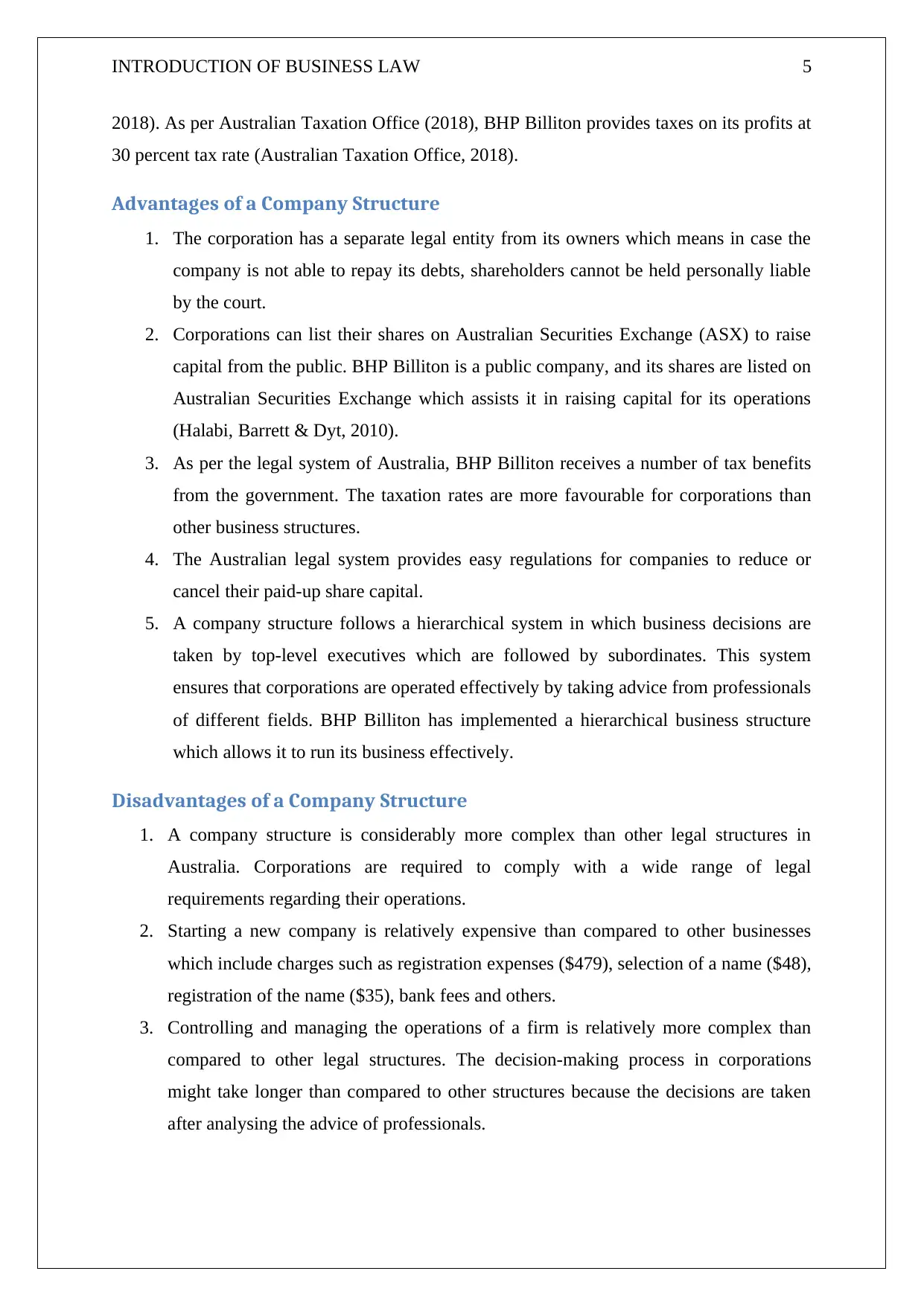
INTRODUCTION OF BUSINESS LAW 5
2018). As per Australian Taxation Office (2018), BHP Billiton provides taxes on its profits at
30 percent tax rate (Australian Taxation Office, 2018).
Advantages of a Company Structure
1. The corporation has a separate legal entity from its owners which means in case the
company is not able to repay its debts, shareholders cannot be held personally liable
by the court.
2. Corporations can list their shares on Australian Securities Exchange (ASX) to raise
capital from the public. BHP Billiton is a public company, and its shares are listed on
Australian Securities Exchange which assists it in raising capital for its operations
(Halabi, Barrett & Dyt, 2010).
3. As per the legal system of Australia, BHP Billiton receives a number of tax benefits
from the government. The taxation rates are more favourable for corporations than
other business structures.
4. The Australian legal system provides easy regulations for companies to reduce or
cancel their paid-up share capital.
5. A company structure follows a hierarchical system in which business decisions are
taken by top-level executives which are followed by subordinates. This system
ensures that corporations are operated effectively by taking advice from professionals
of different fields. BHP Billiton has implemented a hierarchical business structure
which allows it to run its business effectively.
Disadvantages of a Company Structure
1. A company structure is considerably more complex than other legal structures in
Australia. Corporations are required to comply with a wide range of legal
requirements regarding their operations.
2. Starting a new company is relatively expensive than compared to other businesses
which include charges such as registration expenses ($479), selection of a name ($48),
registration of the name ($35), bank fees and others.
3. Controlling and managing the operations of a firm is relatively more complex than
compared to other legal structures. The decision-making process in corporations
might take longer than compared to other structures because the decisions are taken
after analysing the advice of professionals.
2018). As per Australian Taxation Office (2018), BHP Billiton provides taxes on its profits at
30 percent tax rate (Australian Taxation Office, 2018).
Advantages of a Company Structure
1. The corporation has a separate legal entity from its owners which means in case the
company is not able to repay its debts, shareholders cannot be held personally liable
by the court.
2. Corporations can list their shares on Australian Securities Exchange (ASX) to raise
capital from the public. BHP Billiton is a public company, and its shares are listed on
Australian Securities Exchange which assists it in raising capital for its operations
(Halabi, Barrett & Dyt, 2010).
3. As per the legal system of Australia, BHP Billiton receives a number of tax benefits
from the government. The taxation rates are more favourable for corporations than
other business structures.
4. The Australian legal system provides easy regulations for companies to reduce or
cancel their paid-up share capital.
5. A company structure follows a hierarchical system in which business decisions are
taken by top-level executives which are followed by subordinates. This system
ensures that corporations are operated effectively by taking advice from professionals
of different fields. BHP Billiton has implemented a hierarchical business structure
which allows it to run its business effectively.
Disadvantages of a Company Structure
1. A company structure is considerably more complex than other legal structures in
Australia. Corporations are required to comply with a wide range of legal
requirements regarding their operations.
2. Starting a new company is relatively expensive than compared to other businesses
which include charges such as registration expenses ($479), selection of a name ($48),
registration of the name ($35), bank fees and others.
3. Controlling and managing the operations of a firm is relatively more complex than
compared to other legal structures. The decision-making process in corporations
might take longer than compared to other structures because the decisions are taken
after analysing the advice of professionals.
⊘ This is a preview!⊘
Do you want full access?
Subscribe today to unlock all pages.

Trusted by 1+ million students worldwide

INTRODUCTION OF BUSINESS LAW 6
4. Companies have to comply with strict reporting requirements under which they have
to publish their annual statements and major changes in the firm. A corporation’s
affairs are public due to which they lack privacy.
5. Based on the doctrine of piercing of corporate veil, the court can hold directors of a
company personally liable for its illegal actions or debts.
Comparing Advantages and Disadvantages of Different Business
Structures
Sole trader
Advantages
1. Starting a sole trading business is considerably easier than a company because of lack
of legal requirements.
2. Starting a sole trading business is relatively cheaper than a company because it only
involves business name registration fee ($35) and bank fees (Department of Industry,
Innovation and Science, 2017c).
3. The decision making procedure of a sole trading business is substantially easier
because the owner takes all its business decisions. On the other hand, directors take
business decisions in a corporation after consulting the advice of professionals from
different fields which makes the procedure more complex.
4. Financial affairs of a sole trader are private because it did not have to publish or report
its annual statements, whereas, a corporation has to publish all its major decisions and
annual financial statements.
5. A sole trader retains all the profits of the business after paying its staff’s salaries,
whereas, a company’s profits are divided between a number of stakeholders including
employees, shareholders, directors, investors and others.
Disadvantages
1. A sole trading business did not have the option to raise capital from the public,
whereas, a public company can easier list its share on Australian Securities Exchange
and raise capital from the public.
2. A sole trader is personally liable for the debts and liabilities of the business, and the
court can use his/her personal property to settle business debts. On the other hand,
4. Companies have to comply with strict reporting requirements under which they have
to publish their annual statements and major changes in the firm. A corporation’s
affairs are public due to which they lack privacy.
5. Based on the doctrine of piercing of corporate veil, the court can hold directors of a
company personally liable for its illegal actions or debts.
Comparing Advantages and Disadvantages of Different Business
Structures
Sole trader
Advantages
1. Starting a sole trading business is considerably easier than a company because of lack
of legal requirements.
2. Starting a sole trading business is relatively cheaper than a company because it only
involves business name registration fee ($35) and bank fees (Department of Industry,
Innovation and Science, 2017c).
3. The decision making procedure of a sole trading business is substantially easier
because the owner takes all its business decisions. On the other hand, directors take
business decisions in a corporation after consulting the advice of professionals from
different fields which makes the procedure more complex.
4. Financial affairs of a sole trader are private because it did not have to publish or report
its annual statements, whereas, a corporation has to publish all its major decisions and
annual financial statements.
5. A sole trader retains all the profits of the business after paying its staff’s salaries,
whereas, a company’s profits are divided between a number of stakeholders including
employees, shareholders, directors, investors and others.
Disadvantages
1. A sole trading business did not have the option to raise capital from the public,
whereas, a public company can easier list its share on Australian Securities Exchange
and raise capital from the public.
2. A sole trader is personally liable for the debts and liabilities of the business, and the
court can use his/her personal property to settle business debts. On the other hand,
Paraphrase This Document
Need a fresh take? Get an instant paraphrase of this document with our AI Paraphraser
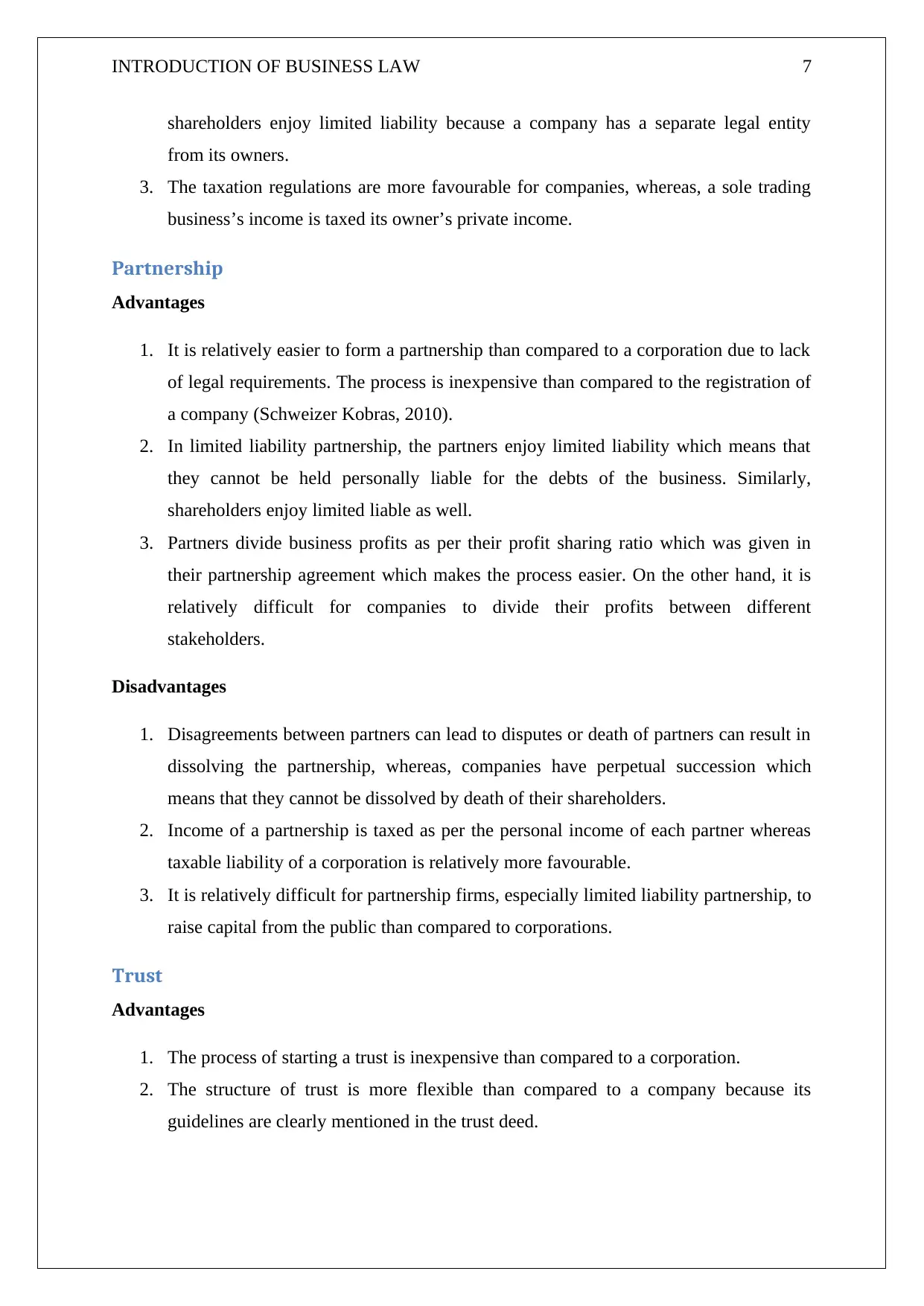
INTRODUCTION OF BUSINESS LAW 7
shareholders enjoy limited liability because a company has a separate legal entity
from its owners.
3. The taxation regulations are more favourable for companies, whereas, a sole trading
business’s income is taxed its owner’s private income.
Partnership
Advantages
1. It is relatively easier to form a partnership than compared to a corporation due to lack
of legal requirements. The process is inexpensive than compared to the registration of
a company (Schweizer Kobras, 2010).
2. In limited liability partnership, the partners enjoy limited liability which means that
they cannot be held personally liable for the debts of the business. Similarly,
shareholders enjoy limited liable as well.
3. Partners divide business profits as per their profit sharing ratio which was given in
their partnership agreement which makes the process easier. On the other hand, it is
relatively difficult for companies to divide their profits between different
stakeholders.
Disadvantages
1. Disagreements between partners can lead to disputes or death of partners can result in
dissolving the partnership, whereas, companies have perpetual succession which
means that they cannot be dissolved by death of their shareholders.
2. Income of a partnership is taxed as per the personal income of each partner whereas
taxable liability of a corporation is relatively more favourable.
3. It is relatively difficult for partnership firms, especially limited liability partnership, to
raise capital from the public than compared to corporations.
Trust
Advantages
1. The process of starting a trust is inexpensive than compared to a corporation.
2. The structure of trust is more flexible than compared to a company because its
guidelines are clearly mentioned in the trust deed.
shareholders enjoy limited liability because a company has a separate legal entity
from its owners.
3. The taxation regulations are more favourable for companies, whereas, a sole trading
business’s income is taxed its owner’s private income.
Partnership
Advantages
1. It is relatively easier to form a partnership than compared to a corporation due to lack
of legal requirements. The process is inexpensive than compared to the registration of
a company (Schweizer Kobras, 2010).
2. In limited liability partnership, the partners enjoy limited liability which means that
they cannot be held personally liable for the debts of the business. Similarly,
shareholders enjoy limited liable as well.
3. Partners divide business profits as per their profit sharing ratio which was given in
their partnership agreement which makes the process easier. On the other hand, it is
relatively difficult for companies to divide their profits between different
stakeholders.
Disadvantages
1. Disagreements between partners can lead to disputes or death of partners can result in
dissolving the partnership, whereas, companies have perpetual succession which
means that they cannot be dissolved by death of their shareholders.
2. Income of a partnership is taxed as per the personal income of each partner whereas
taxable liability of a corporation is relatively more favourable.
3. It is relatively difficult for partnership firms, especially limited liability partnership, to
raise capital from the public than compared to corporations.
Trust
Advantages
1. The process of starting a trust is inexpensive than compared to a corporation.
2. The structure of trust is more flexible than compared to a company because its
guidelines are clearly mentioned in the trust deed.
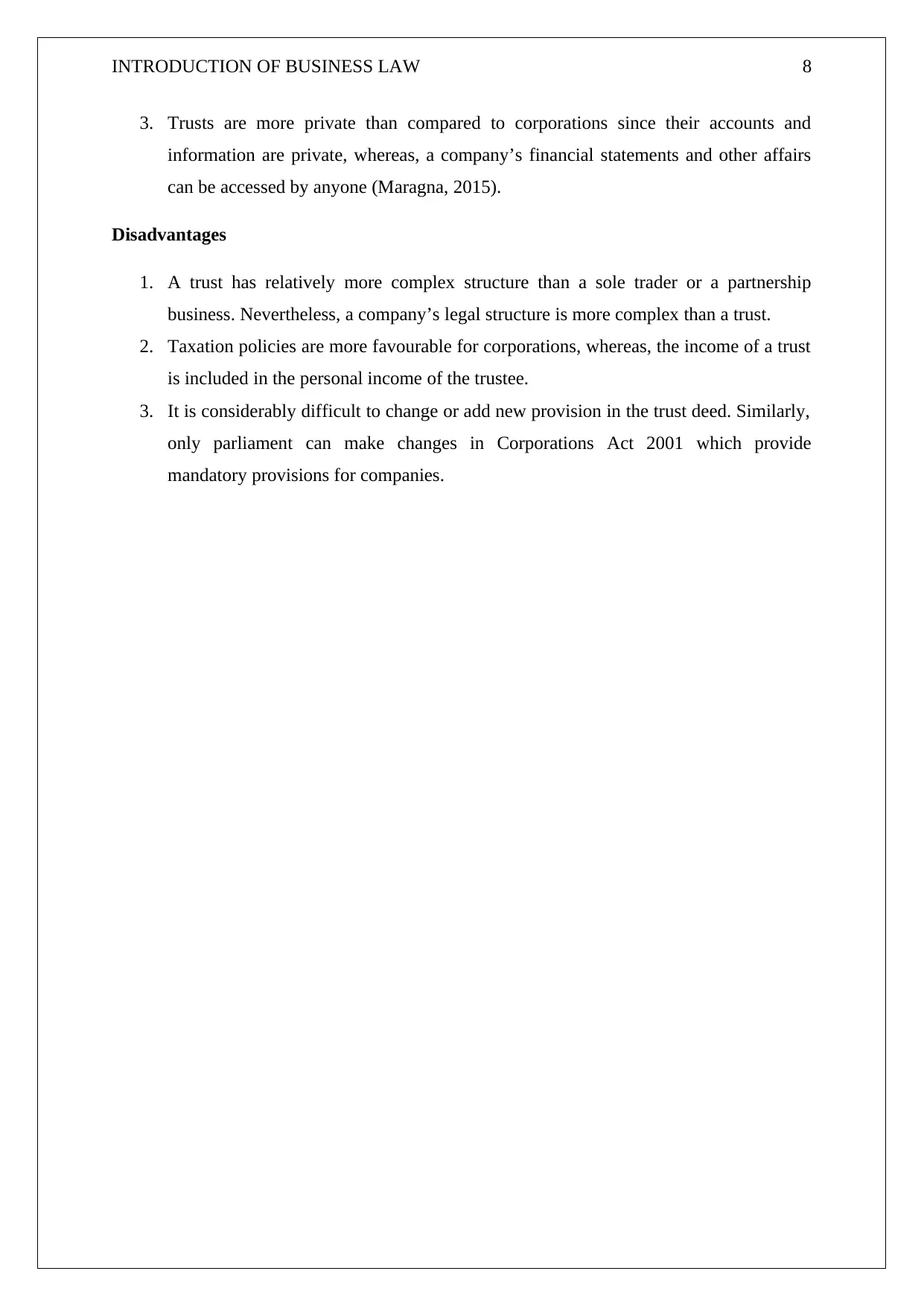
INTRODUCTION OF BUSINESS LAW 8
3. Trusts are more private than compared to corporations since their accounts and
information are private, whereas, a company’s financial statements and other affairs
can be accessed by anyone (Maragna, 2015).
Disadvantages
1. A trust has relatively more complex structure than a sole trader or a partnership
business. Nevertheless, a company’s legal structure is more complex than a trust.
2. Taxation policies are more favourable for corporations, whereas, the income of a trust
is included in the personal income of the trustee.
3. It is considerably difficult to change or add new provision in the trust deed. Similarly,
only parliament can make changes in Corporations Act 2001 which provide
mandatory provisions for companies.
3. Trusts are more private than compared to corporations since their accounts and
information are private, whereas, a company’s financial statements and other affairs
can be accessed by anyone (Maragna, 2015).
Disadvantages
1. A trust has relatively more complex structure than a sole trader or a partnership
business. Nevertheless, a company’s legal structure is more complex than a trust.
2. Taxation policies are more favourable for corporations, whereas, the income of a trust
is included in the personal income of the trustee.
3. It is considerably difficult to change or add new provision in the trust deed. Similarly,
only parliament can make changes in Corporations Act 2001 which provide
mandatory provisions for companies.
⊘ This is a preview!⊘
Do you want full access?
Subscribe today to unlock all pages.

Trusted by 1+ million students worldwide
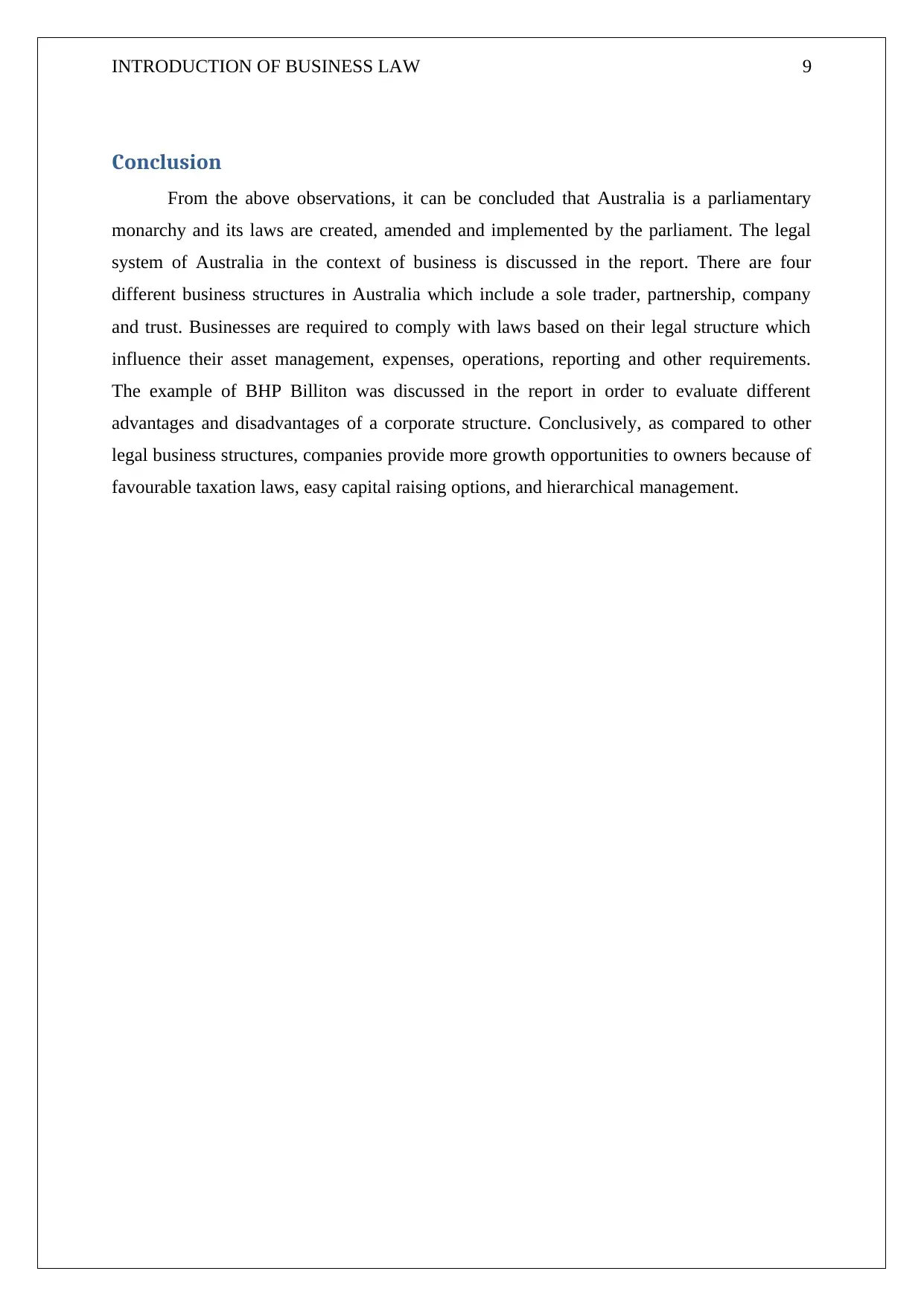
INTRODUCTION OF BUSINESS LAW 9
Conclusion
From the above observations, it can be concluded that Australia is a parliamentary
monarchy and its laws are created, amended and implemented by the parliament. The legal
system of Australia in the context of business is discussed in the report. There are four
different business structures in Australia which include a sole trader, partnership, company
and trust. Businesses are required to comply with laws based on their legal structure which
influence their asset management, expenses, operations, reporting and other requirements.
The example of BHP Billiton was discussed in the report in order to evaluate different
advantages and disadvantages of a corporate structure. Conclusively, as compared to other
legal business structures, companies provide more growth opportunities to owners because of
favourable taxation laws, easy capital raising options, and hierarchical management.
Conclusion
From the above observations, it can be concluded that Australia is a parliamentary
monarchy and its laws are created, amended and implemented by the parliament. The legal
system of Australia in the context of business is discussed in the report. There are four
different business structures in Australia which include a sole trader, partnership, company
and trust. Businesses are required to comply with laws based on their legal structure which
influence their asset management, expenses, operations, reporting and other requirements.
The example of BHP Billiton was discussed in the report in order to evaluate different
advantages and disadvantages of a corporate structure. Conclusively, as compared to other
legal business structures, companies provide more growth opportunities to owners because of
favourable taxation laws, easy capital raising options, and hierarchical management.
Paraphrase This Document
Need a fresh take? Get an instant paraphrase of this document with our AI Paraphraser
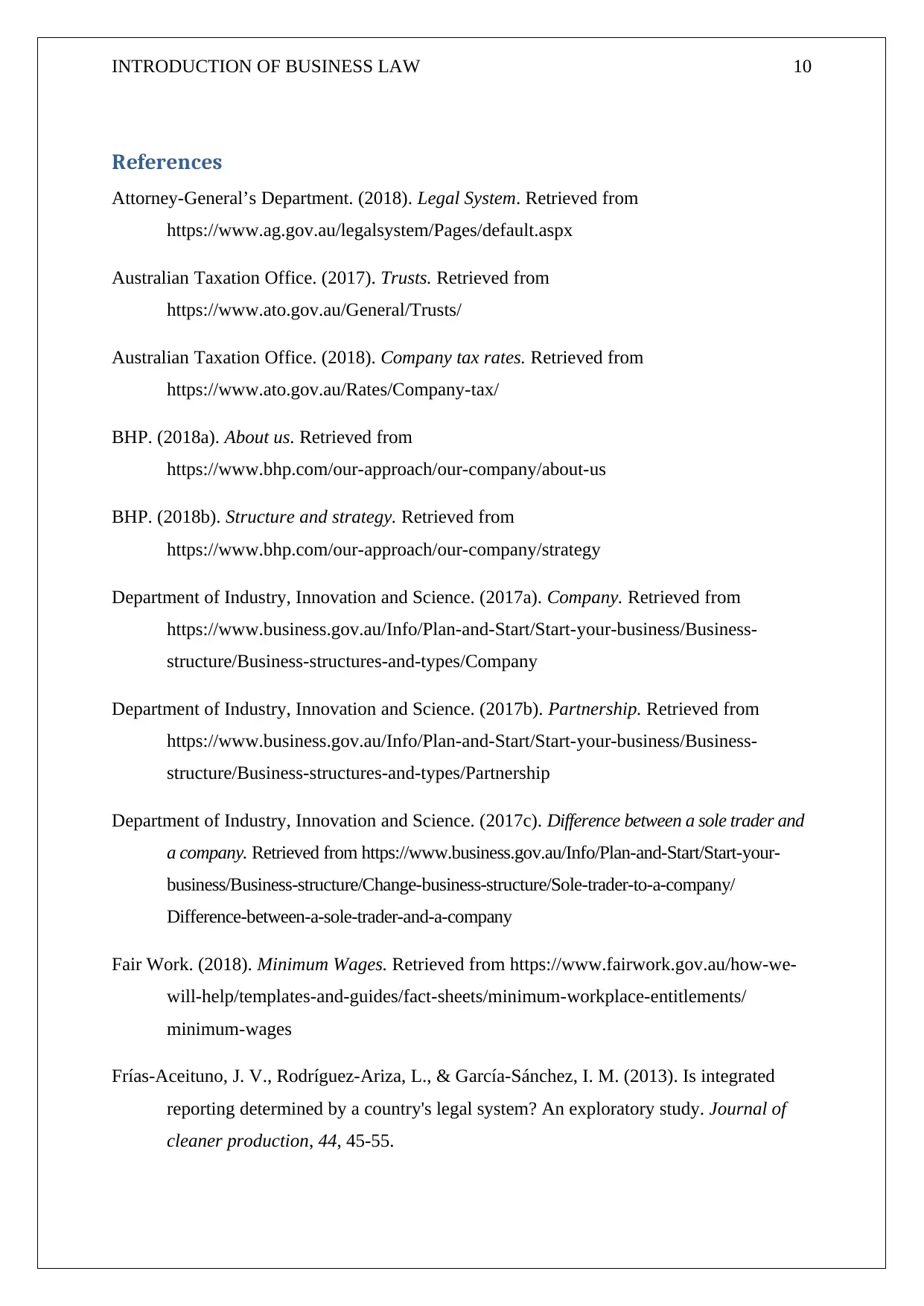
INTRODUCTION OF BUSINESS LAW 10
References
Attorney-General’s Department. (2018). Legal System. Retrieved from
https://www.ag.gov.au/legalsystem/Pages/default.aspx
Australian Taxation Office. (2017). Trusts. Retrieved from
https://www.ato.gov.au/General/Trusts/
Australian Taxation Office. (2018). Company tax rates. Retrieved from
https://www.ato.gov.au/Rates/Company-tax/
BHP. (2018a). About us. Retrieved from
https://www.bhp.com/our-approach/our-company/about-us
BHP. (2018b). Structure and strategy. Retrieved from
https://www.bhp.com/our-approach/our-company/strategy
Department of Industry, Innovation and Science. (2017a). Company. Retrieved from
https://www.business.gov.au/Info/Plan-and-Start/Start-your-business/Business-
structure/Business-structures-and-types/Company
Department of Industry, Innovation and Science. (2017b). Partnership. Retrieved from
https://www.business.gov.au/Info/Plan-and-Start/Start-your-business/Business-
structure/Business-structures-and-types/Partnership
Department of Industry, Innovation and Science. (2017c). Difference between a sole trader and
a company. Retrieved from https://www.business.gov.au/Info/Plan-and-Start/Start-your-
business/Business-structure/Change-business-structure/Sole-trader-to-a-company/
Difference-between-a-sole-trader-and-a-company
Fair Work. (2018). Minimum Wages. Retrieved from https://www.fairwork.gov.au/how-we-
will-help/templates-and-guides/fact-sheets/minimum-workplace-entitlements/
minimum-wages
Frías-Aceituno, J. V., Rodríguez-Ariza, L., & García-Sánchez, I. M. (2013). Is integrated
reporting determined by a country's legal system? An exploratory study. Journal of
cleaner production, 44, 45-55.
References
Attorney-General’s Department. (2018). Legal System. Retrieved from
https://www.ag.gov.au/legalsystem/Pages/default.aspx
Australian Taxation Office. (2017). Trusts. Retrieved from
https://www.ato.gov.au/General/Trusts/
Australian Taxation Office. (2018). Company tax rates. Retrieved from
https://www.ato.gov.au/Rates/Company-tax/
BHP. (2018a). About us. Retrieved from
https://www.bhp.com/our-approach/our-company/about-us
BHP. (2018b). Structure and strategy. Retrieved from
https://www.bhp.com/our-approach/our-company/strategy
Department of Industry, Innovation and Science. (2017a). Company. Retrieved from
https://www.business.gov.au/Info/Plan-and-Start/Start-your-business/Business-
structure/Business-structures-and-types/Company
Department of Industry, Innovation and Science. (2017b). Partnership. Retrieved from
https://www.business.gov.au/Info/Plan-and-Start/Start-your-business/Business-
structure/Business-structures-and-types/Partnership
Department of Industry, Innovation and Science. (2017c). Difference between a sole trader and
a company. Retrieved from https://www.business.gov.au/Info/Plan-and-Start/Start-your-
business/Business-structure/Change-business-structure/Sole-trader-to-a-company/
Difference-between-a-sole-trader-and-a-company
Fair Work. (2018). Minimum Wages. Retrieved from https://www.fairwork.gov.au/how-we-
will-help/templates-and-guides/fact-sheets/minimum-workplace-entitlements/
minimum-wages
Frías-Aceituno, J. V., Rodríguez-Ariza, L., & García-Sánchez, I. M. (2013). Is integrated
reporting determined by a country's legal system? An exploratory study. Journal of
cleaner production, 44, 45-55.

INTRODUCTION OF BUSINESS LAW 11
Halabi, A. K., Barrett, R., & Dyt, R. (2010). Understanding financial information used to
assess small firm performance: An Australian qualitative study. Qualitative Research
in Accounting & Management, 7(2), 163-179.
Maragna, O. (2015). Is ownership always in your best interests? Company vs Trust.
Retrieved from https://www.smh.com.au/business/investments/is-ownership-always-
in-your-best-interests-company-vs-trust-20150324-1m6d2i.html
Parliamentary Education Office. (2018). Governing Australia: three levels of law-making.
Retrieved from https://www.peo.gov.au/learning/closer-look/governing-australia.html
Rembar, C. (2015). The law of the land: The evolution of our legal system. Open Road
Media.
Schweizer Kobras. (2010). Business Structure in Australia. Retrieved from
http://www.schweizer.com.au/articles/Business_Structures_in_Australia_(SK0012544
5).pdf
Singleton, G., Aitkin, D., Jinks, B., & Warhurst, J. (2012). Australian Politcal Institutions.
Pearson Higher Education AU.
Ward, R. (2011). Walker & Walker's English legal system. Oxford University Press.
WIPO. (2018). Corporations Act 2001. Retrieved from
http://www.wipo.int/edocs/lexdocs/laws/en/au/au196en.pdf
Halabi, A. K., Barrett, R., & Dyt, R. (2010). Understanding financial information used to
assess small firm performance: An Australian qualitative study. Qualitative Research
in Accounting & Management, 7(2), 163-179.
Maragna, O. (2015). Is ownership always in your best interests? Company vs Trust.
Retrieved from https://www.smh.com.au/business/investments/is-ownership-always-
in-your-best-interests-company-vs-trust-20150324-1m6d2i.html
Parliamentary Education Office. (2018). Governing Australia: three levels of law-making.
Retrieved from https://www.peo.gov.au/learning/closer-look/governing-australia.html
Rembar, C. (2015). The law of the land: The evolution of our legal system. Open Road
Media.
Schweizer Kobras. (2010). Business Structure in Australia. Retrieved from
http://www.schweizer.com.au/articles/Business_Structures_in_Australia_(SK0012544
5).pdf
Singleton, G., Aitkin, D., Jinks, B., & Warhurst, J. (2012). Australian Politcal Institutions.
Pearson Higher Education AU.
Ward, R. (2011). Walker & Walker's English legal system. Oxford University Press.
WIPO. (2018). Corporations Act 2001. Retrieved from
http://www.wipo.int/edocs/lexdocs/laws/en/au/au196en.pdf
⊘ This is a preview!⊘
Do you want full access?
Subscribe today to unlock all pages.

Trusted by 1+ million students worldwide
1 out of 12
Related Documents
Your All-in-One AI-Powered Toolkit for Academic Success.
+13062052269
info@desklib.com
Available 24*7 on WhatsApp / Email
![[object Object]](/_next/static/media/star-bottom.7253800d.svg)
Unlock your academic potential
Copyright © 2020–2025 A2Z Services. All Rights Reserved. Developed and managed by ZUCOL.



